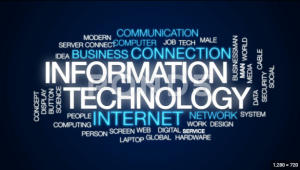Information Technology: Revolutionizing the World
- Introduction to Information Technology
- Evolution of Information Technology
- Early developments
- Modern advancements
- Importance of Information Technology
- Business sector
- Education sector
- Healthcare sector
- Key Components of Information Technology
- Hardware
- Software
- Networks

- Role of Information Technology in Business
- Communication
- Automation
- Data management
- Impact of Information Technology on Education
- E-learning
- Digital libraries
- Interactive learning tools
- Information Technology in Healthcare
- Electronic medical records
- Telemedicine
- Medical research and diagnostics
- Cybersecurity in Information Technology
- Importance of cybersecurity
- Measures to ensure cybersecurity
- Future Trends in Information Technology
- Artificial intelligence and machine learning
- Internet of Things (IoT)
- Blockchain technology
- Challenges in Information Technology
- Privacy concerns
- Digital divide
- Rapid technological advancements
- Conclusion
Information Technology: Revolutionizing the World
In today’s digital age, information technology (IT) stands at the forefront of innovation, driving advancements across various sectors and transforming the way we live, work, and communicate. From the early days of mainframe computers to the current era of cloud computing and artificial intelligence, the evolution of IT has been nothing short of remarkable.
Evolution of Information Technology
Early Developments
Information technology traces its roots back to the invention of the abacus, considered the earliest computing device. Over the centuries, various developments such as the invention of the mechanical calculator, telegraph, and early computers like ENIAC paved the way for modern IT systems.
Modern Advancements
The rapid advancements in microprocessors, software development, and telecommunications have led to the proliferation of IT in every aspect of our lives. The emergence of the internet, mobile devices, and high-speed networks has connected the world like never before, facilitating instant access to information and communication across the globe.
Importance of Information Technology
Information technology plays a pivotal role in driving innovation, efficiency, and productivity across different sectors.
Business Sector
In the business world, IT has revolutionized operations, enabling automation of tasks, efficient communication through emails and video conferencing, and streamlining of business processes through enterprise resource planning (ERP) systems. It has also opened up new avenues for e-commerce, allowing businesses to reach global markets and conduct transactions seamlessly.
Education Sector
In education, IT has transformed traditional learning methods, offering access to online courses, digital textbooks, and interactive learning platforms. It has made education more accessible and personalized, catering to diverse learning needs and enabling lifelong learning opportunities.
Healthcare Sector
The healthcare industry has benefited immensely from IT advancements, with electronic medical records (EMRs), telemedicine, and medical imaging technologies enhancing patient care, diagnosis, and treatment outcomes. IT has facilitated remote consultations, real-time monitoring of patients, and collaborative research efforts, leading to improved healthcare delivery worldwide.
Key Components of Information Technology
Information technology comprises three fundamental components:
Hardware
Hardware refers to the physical components of a computer system, including the central processing unit (CPU), memory, storage devices, input/output devices, and networking equipment. It forms the backbone of IT infrastructure, providing the necessary computing power and resources to process and store data.
Software
Software encompasses the programs, applications, and operating systems that enable users to perform various tasks on computers and other digital devices. It includes system software (e.g., operating systems) and application software (e.g., word processors, web browsers), providing functionality and utility to users.
Networks
Networks facilitate communication and data exchange between devices and systems, allowing users to share resources, access information remotely, and collaborate in real-time. They can be wired or wireless and range from local area networks (LANs) within a single location to wide area networks (WANs) connecting geographically dispersed locations.
Role of Information Technology in Business
Information technology plays a crucial role in driving innovation and efficiency in the business sector.
Communication
IT facilitates seamless communication within organizations and with external stakeholders through email, instant messaging, video conferencing, and collaboration tools. It enables real-time interaction, faster decision-making, and improved coordination among team members, regardless of their geographical location.
Automation
Automation of repetitive tasks and business processes is made possible through IT solutions such as robotic process automation (RPA), workflow management systems, and artificial intelligence (AI). It streamlines operations, reduces manual errors, and enhances productivity by freeing up employees to focus on higher-value tasks.
Data Management
IT enables efficient management and analysis of vast amounts of data generated by businesses, helping them gain valuable insights and make data-driven decisions. Big data analytics, data visualization tools, and business intelligence platforms empower organizations to identify trends, forecast future outcomes, and optimize their strategies for growth and profitability.
Impact of Information Technology on Education
Information technology has revolutionized the field of education, reshaping teaching and learning practices worldwide.
E-Learning
E-learning platforms and online courses provide students with flexible and accessible learning opportunities, allowing them to study at their own pace and convenience. It caters to diverse learning styles and preferences, offering multimedia-rich content, interactive simulations, and personalized feedback to enhance the learning experience.
Digital Libraries
Digital libraries and online repositories grant students and researchers instant access to a wealth of educational resources, including textbooks, research papers, and multimedia materials. It promotes self-directed learning, facilitates collaborative research projects, and democratizes access to knowledge regardless of geographical barriers.
Interactive Learning Tools
IT tools such as virtual reality (VR), augmented reality (AR), and gamified learning applications engage students in immersive and interactive learning experiences. They stimulate curiosity, creativity, and critical thinking skills, making learning more engaging and effective across diverse subjects and disciplines.
Information Technology in Healthcare
Information technology has revolutionized healthcare delivery, improving patient outcomes, and enhancing operational efficiency in the healthcare sector.
Electronic Medical Records
Electronic medical records (EMRs) digitize patient health information, enabling healthcare providers to access and update medical records electronically. It ensures the accuracy, completeness, and security of patient data, facilitates real-time information sharing between healthcare professionals, and supports evidence-based decision-making in clinical practice.
Telemedicine
Telemedicine allows healthcare professionals to deliver medical services remotely, leveraging telecommunications and digital technologies. It enables virtual consultations, remote monitoring of patients’ vital signs, and electronic prescriptions, expanding access to healthcare services in underserved areas and improving patient convenience and satisfaction.
Medical Research and Diagnostics
IT tools and technologies facilitate medical research and diagnostics, accelerating the discovery of new treatments, drugs, and medical devices. High-performance computing, bioinformatics, and medical imaging techniques enable researchers to analyze complex biological data, simulate disease processes, and develop personalized treatment plans tailored to individual patients’ needs.
Cybersecurity in Information Technology
Cybersecurity is paramount in protecting sensitive data, preserving privacy, and safeguarding against cyber threats and attacks.
Importance of Cybersecurity
Cybersecurity ensures the confidentiality, integrity, and availability of digital assets and information systems, preventing unauthorized access, data breaches, and cybercrimes. It instills






